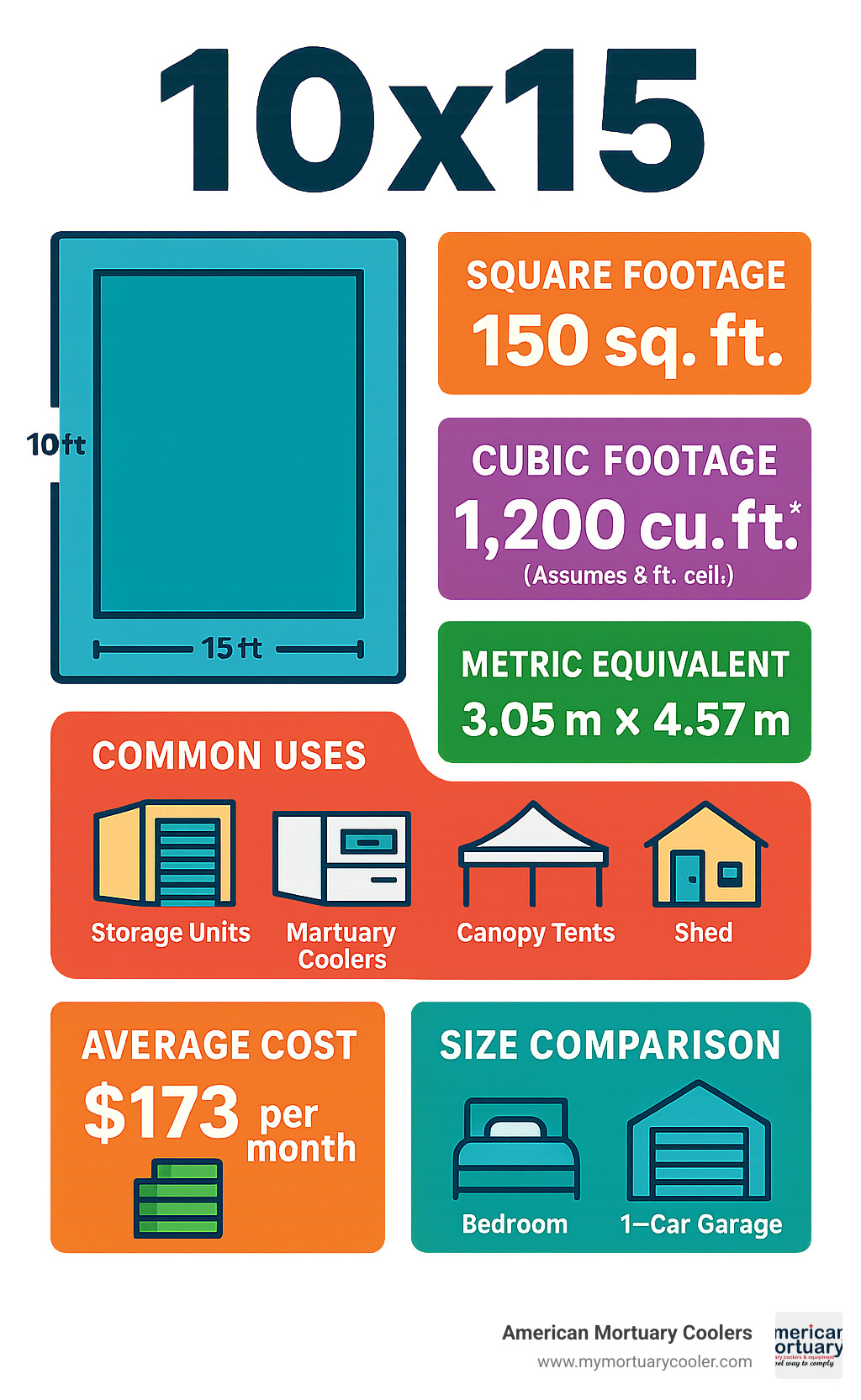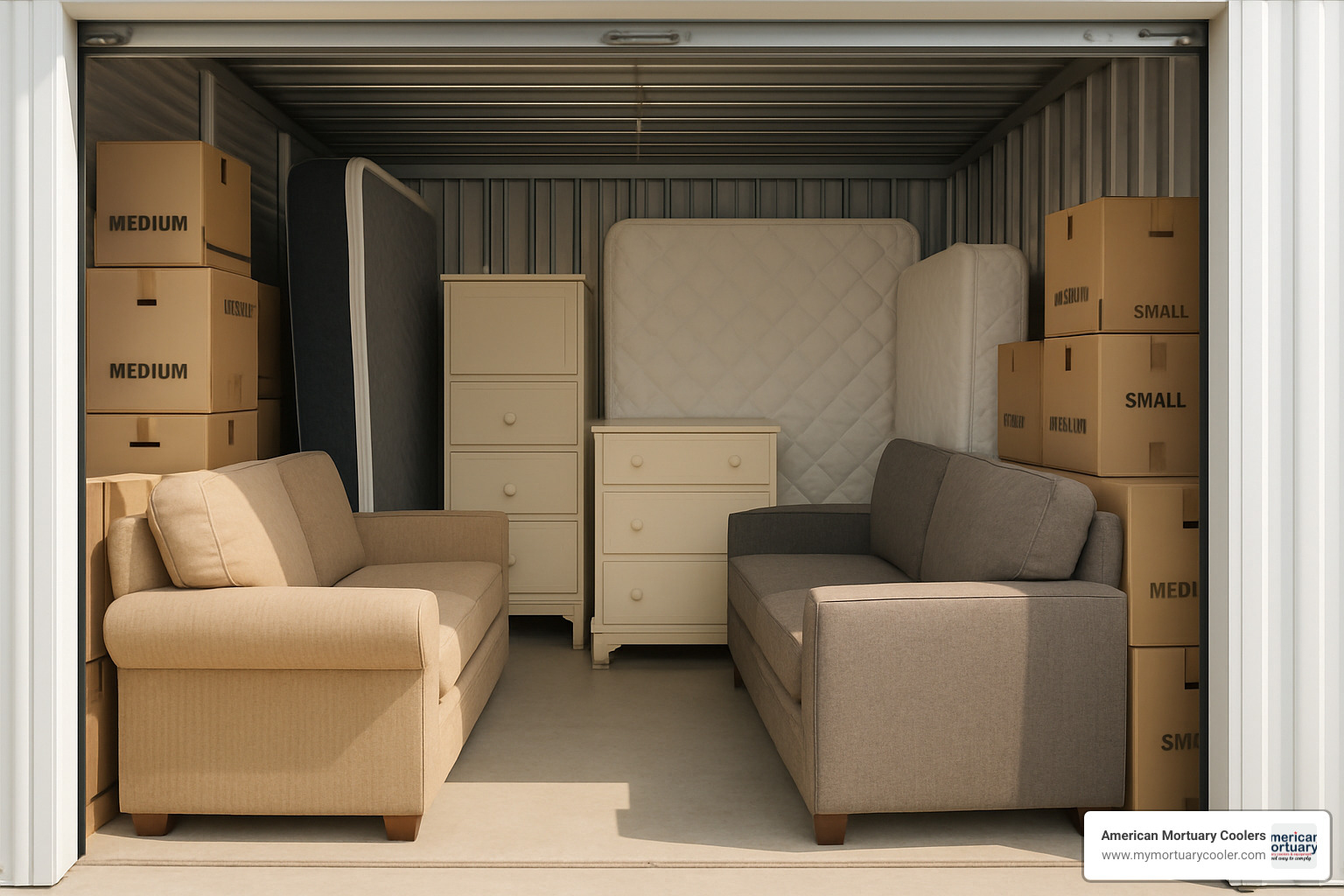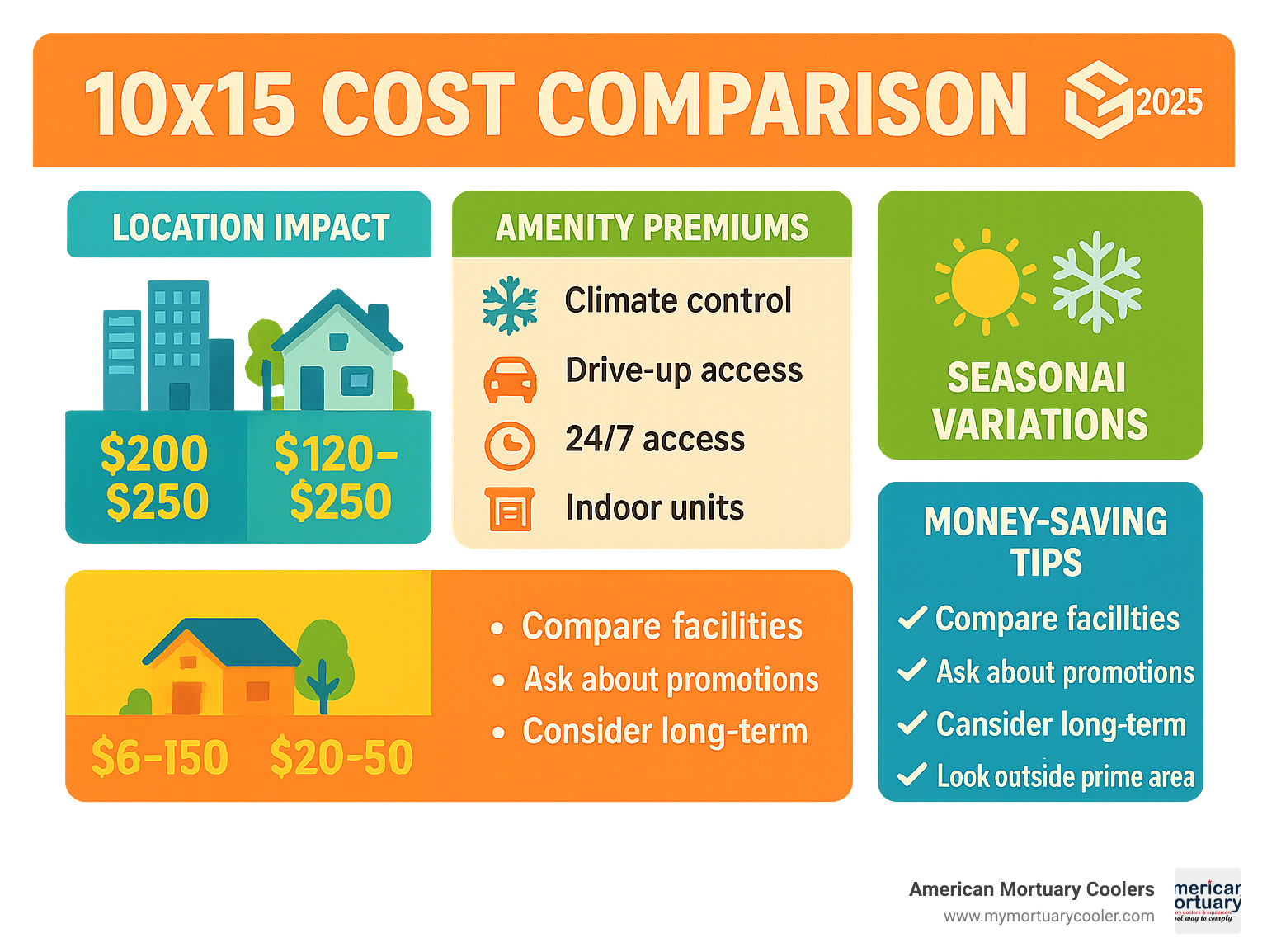Understanding the Versatile 10x15 Dimension
10x15 is a popular dimensional specification that appears across many industries, from storage units to sheds, tents, and specialized equipment. Here's what you need to know about this versatile size:
Quick 10x15 Facts:
- Size: 10 feet wide by 15 feet long
- Area: 150 square feet (equivalent to a large bedroom)
- Volume: 1,200 cubic feet (with 8-foot ceiling)
- Metric: 3.05m × 4.57m (304.8cm × 457.2cm)
- Common Uses: Storage units, sheds, canopy tents, photo prints, mortuary coolers
Whether you're planning storage space, considering a shed, or evaluating specialized equipment, the 10x15 footprint offers a practical middle ground. It's large enough to hold substantial contents - typically fitting three bedrooms worth of furniture or serving as a spacious work area - yet compact enough to fit most residential and commercial properties.
Research shows that a 10x15 storage unit costs an average of $173 per month nationally, with prices ranging from $61 to $389 depending on location and amenities. The space accommodates everything from household furniture and appliances to small vehicles like motorcycles, making it one of the most versatile medium-sized options available.
As American Mortuary Coolers, we've worked extensively with funeral home directors who need reliable equipment that fits specific space constraints, including many 10x15 mortuary cooler installations. Our experience in the funeral service industry has shown us how critical proper space planning and equipment sizing can be for operational efficiency.

Mastering the 10x15 Size: Dimensions & Conversions
Getting a handle on 10x15 dimensions is about more than just memorizing numbers. When you're planning for storage, building a shed, or selecting equipment, you need to truly understand how this space translates into real-world usability.
| Measurement | Feet | Meters | Centimeters |
|---|---|---|---|
| Width | 10 ft | 3.05 m | 304.8 cm |
| Length | 15 ft | 4.57 m | 457.2 cm |
| Area | 150 sq ft | 13.94 sq m | - |
10x15 in Feet, Meters & Centimeters
A 10x15 space gives you exactly what the name suggests - 10 feet wide by 15 feet long. This creates a generous 150 square feet of floor space to work with. When you factor in the standard 8-foot ceiling height that most storage facilities and structures use, you're looking at roughly 1,200 cubic feet of total volume.
For anyone working with metric measurements, the 304.8 cm conversion is your go-to number. Simply multiply any foot measurement by 30.48 to get centimeters, or use 0.3048 for meters. So your 10x15 becomes 3.05 meters by 4.57 meters - still a substantial space in any measurement system.
The length-width-height combination creates a surprisingly roomy environment. You're not dealing with a cramped square box, but rather a rectangular space that offers flexibility in how you arrange and access your items.
10x15 Volume: Square & Cubic Footage
Picture walking into a large bedroom - that's essentially what you get with a 10x15 footprint. Or think of it as roughly two-thirds of a standard garage. These room analogies help you visualize exactly what you're working with.
That 1,200 cubic feet of volume is more generous than it might sound. You could fit the contents of an entire three-bedroom apartment, including bedroom sets, sofas, dining room furniture, appliances, and dozens of boxes. It's like having a moving-truck analogy - you could pack a good-sized moving truck with what fits in this space.
The proportions work beautifully for organization too. The 10-foot width lets you create a walkway down the middle with storage on both sides, while the 15-foot depth gives you room to stack items without creating a frustrating maze. Some facilities even offer 10-foot ceilings, bumping your volume up to 1,500 cubic feet - that's like adding a walk-in closet's worth of extra space above your head.
Popular Uses for 10x15 Spaces
The 10x15 dimension has become a sweet spot across countless industries, and once you understand why, you'll start noticing it everywhere. This size hits that perfect balance - big enough to be genuinely useful, yet manageable enough that it won't overwhelm your space or budget.

Storage & Moving
When people think 10x15, storage units usually come to mind first - and there's a good reason this size dominates the self-storage world. A 10x15 unit can swallow up everything from a two-bedroom apartment without breaking a sweat. We're talking multiple bedroom sets with all the trimmings, living room furniture including those oversized sectionals that seemed like such a good idea at the furniture store, and even major appliances like refrigerators and washers.
The real magic happens when you add climate control to the mix. These units maintain steady temperatures between 55-80°F, which means your grandmother's antique dresser and your vinyl record collection stay protected from Tennessee's notorious humidity swings. Drive-up access is another game-changer - there's nothing quite like being able to back your truck right up to the door when you're wrestling with a queen-size mattress.
Here's where it gets interesting from a budget perspective: the national average for a 10x15 storage unit sits around $173 monthly, but location makes all the difference. You might pay $389 in Manhattan, while rural areas can offer the same space for just $61. For more detailed pricing insights, check out this 10x15 Storage Unit Size Guide that breaks down costs by region.
Outdoor Structures & Events
Step outside, and 10x15 dimensions really start to shine. Welcome to Ten by Fifteen Structures has built their entire business around stretch tents in this exact footprint, and they're onto something special. These aren't your typical backyard party tents - we're talking about professional-grade structures that can handle everything from intimate wedding receptions to corporate product launches.
The beauty of a 10x15 event space is its versatility. It's intimate enough for a family gathering yet spacious enough for a serious business presentation. Pop-up canopies in this size typically max out at 11 feet of peak height, giving you plenty of headroom while staying manageable for a two-person setup crew.
Farmers markets, craft fairs, and outdoor trade shows have acceptd this dimension because it provides serious display space without requiring a commercial vehicle to transport. Most 10x15 canopies break down into packages that fit in a standard pickup truck or large SUV.
Specialty Applications
This is where things get really interesting. In the photography world, 10x15-inch prints have become the go-to size for professional portfolios. These prints strike the perfect balance between impact and practicality - large enough to showcase fine details, yet manageable enough for client presentations. When printed on quality archive paper, they'll outlast most of us, staying vibrant for well over 100 years under normal display conditions.
For funeral service professionals, 10x15 mortuary coolers represent a critical piece of equipment that must fit into existing facility layouts while meeting strict regulatory requirements. The Definitive Guide to 10x15 Mortuary Coolers covers the technical specifications these units must meet, including NSF and UL standards that ensure both safety and reliability.
Small vehicle storage rounds out the specialty applications nicely. While your family sedan won't squeeze into a 10x15 space, motorcycles, jet skis, snowmobiles, and even some compact cars fit comfortably with room left over for helmets, maintenance supplies, and seasonal gear. It's like having a dedicated garage bay without the construction project.
Planning, Budgeting & Organizing Your 10x15 Area
Whether you're renting storage space, building a shed, or installing specialized equipment, proper planning ensures you maximize your 10x15 investment. The key is understanding upfront costs, local regulations, and smart organization strategies that make your space work harder for you.

Budgeting for a 10x15
Let's talk money - because nobody likes budget surprises. 10x15 storage unit costs swing wildly depending on where you live and what amenities you need. The national average sits at $173.47 per month, but don't let that fool you into thinking it's the same everywhere.
If you're in a major city like New York or Los Angeles, you might pay up to $389 monthly for prime real estate. Rural areas are much kinder to your wallet, with some units available for as low as $61 per month. Most facilities also tack on a $29 one-time admin charge and a $19.99 lock fee to get you started.
Building your own 10x15 shed? That's a bigger upfront investment but gives you permanent ownership. Expect to spend $3,545 to $7,340 depending on your style preferences and materials. Mini Barn styles run $3,545 for DuraTemp construction up to $4,395 for vinyl. Gable styles cost $4,055 to $5,195, while High Wall styles range from $4,395 to $5,240.
Climate-controlled units cost 20-40% more than standard units, but they're worth every penny if you're storing anything sensitive to temperature changes. For detailed pricing breakdowns in your area, the 10x15 Storage Unit Size Guide offers comprehensive market data.
Permit & Zoning Checklist
Here's where things get a bit bureaucratic, but don't worry - it's not as complicated as it sounds. Most cities require permits for structures over 120 square feet, and since a 10x15 space equals exactly 150 square feet, you'll likely need paperwork.
Municipal codes vary dramatically from town to town, so your first stop should be the local building department. Some areas are surprisingly relaxed about small structures, while others have strict rules about everything from materials to roof pitch.
HOA restrictions can be even trickier than city codes. Some homeowner associations have specific rules about shed colors, placement, or even whether you can have one at all. Check your HOA guidelines before you fall in love with any particular design.
Temporary structures like tents and canopies often play by different rules. Many areas don't require permits for structures that aren't permanently attached to the ground, but always verify first.
Don't forget about setback requirements - that's the mandatory distance between your structure and property lines or other buildings. These rules exist for good reasons (like fire safety), so factor them into your placement plans early.
Pros & Cons Snapshot
Every size has its sweet spots and limitations. 10x15 spaces shine because they're versatile enough to handle everything from household storage to small business inventory. They're more affordable than larger alternatives while still offering substantial capacity.
The flexibility is remarkable - you can store the contents of multiple bedrooms, set up a workshop, or even fit small vehicles like motorcycles or jet skis. Most residential and commercial properties can accommodate this footprint without major site preparation.
However, most standard cars won't fit in a 10x15 space, which disappoints some people hoping for vehicle storage. The space also requires good organization skills to maintain easy access to your belongings. If you only need minimal storage, you might find this size larger (and more expensive) than necessary.
Climate control is fantastic for protecting your belongings, but it adds significant cost to your monthly budget. Weigh the protection benefits against the extra expense based on what you're actually storing.
Smart Organization Hacks
Making the most of your 10x15 space is part art, part science, and part common sense. The secret is thinking vertically while maintaining easy access to everything you store.
Freestanding shelving units along the walls are your best friend. They maximize vertical space without damaging the unit (which could cost you your security deposit). Avoid permanent fixtures that might violate rental agreements.
Plan a clear central aisle down the middle of your space. This walkway becomes your highway for accessing items stored on both sides. Without it, you'll find yourself playing an expensive game of Tetris every time you need something from the back.
Heavy items belong on the floor - this isn't just about convenience, it's about safety. Stack lighter boxes and items on top, working your way up to the ceiling. Your back will thank you, and you'll avoid dangerous avalanches.
Dismantling furniture might seem like extra work, but it's often the difference between fitting everything and needing a larger unit. Use hidden spaces like dresser drawers to store smaller items - it's like getting free storage containers.
Label everything clearly and keep a master list of what's stored where. Future you will appreciate the time investment when you're searching for specific items months later. Trust us on this one - even the most organized person forgets where they put things after a few months.
In climate-controlled units, store sensitive items away from walls to ensure even temperature distribution. The center of the unit typically maintains the most consistent conditions.
Frequently Asked Questions About 10x15

Can a car fit in a 10x15 storage unit?
The short answer: it depends on your vehicle's size. Most standard sedans, SUVs, and trucks won't fit comfortably in a 10x15 unit. However, compact cars might squeeze in, though you'll have minimal room for other items.
What definitely fits:
- Motorcycles with plenty of room for gear
- Jet skis and personal watercraft
- Small boats and trailers
- ATVs and golf carts
- Compact cars (measure first!)
What typically doesn't fit:
- Full-size sedans
- SUVs and pickup trucks
- Most crossover vehicles
Always measure your vehicle before committing to a 10x15 unit for car storage. If vehicle storage is your primary need, consider a 10x20 or larger unit instead.
Do I need a permit for a 10x15 shed?
Since a 10x15 shed covers 150 square feet, it typically exceeds the 120-square-foot threshold that triggers permit requirements in most municipalities. However, regulations vary widely:
Generally requires permits:
- Permanent foundations
- Electrical connections
- Plumbing installations
- Structures over 120 square feet
May not require permits:
- Temporary structures
- Structures on skids (not permanent foundations)
- Areas with higher square footage thresholds
Always check:
- Local building codes
- HOA restrictions
- Setback requirements
- Height limitations
Contact your local building department early in the planning process to understand specific requirements for your area.
How much does a 10x15 space cost per month?
10x15 storage unit pricing varies significantly based on several factors:
Location impact:
- Urban areas: $200-$389 per month
- Suburban areas: $120-$250 per month
- Rural areas: $61-$150 per month
Amenity premiums:
- Climate control: +20-40%
- Drive-up access: +$10-30
- 24/7 access: +$15-25
- Indoor units: +$20-50
Seasonal variations:
- Summer months typically see higher demand and prices
- Winter rates may be lower in some regions
- Holiday seasons can affect availability
Money-saving tips:
- Compare multiple facilities in your area
- Ask about promotional rates for new customers
- Consider longer-term contracts for discounts
- Look for facilities slightly outside prime locations

Conclusion
The 10x15 dimension has proven itself as a remarkably practical choice across countless applications. Whether you're tackling a storage challenge, planning a backyard shed, or specifying specialized equipment, this size delivers that sweet spot between having enough room and keeping things manageable.
Think about it - with 150 square feet of floor space and up to 1,500 cubic feet of volume, you're getting the equivalent of a large bedroom or about two-thirds of a standard garage. That's substantial space without the overwhelming commitment of something massive.
The beauty of working with 10x15 dimensions is how they translate seamlessly across different needs. The metric conversions (3.05m × 4.57m) make international coordination straightforward, while those familiar comparisons help you picture exactly what you're working with before you commit.
From our years of experience at American Mortuary Coolers, we've learned that proper space planning truly makes or breaks any project. We've installed 10x15 mortuary coolers in funeral homes from Johnson City, TN to Los Angeles, CA, and we've seen how this footprint fits beautifully into existing facilities while providing the essential refrigeration capacity our clients need.
The real magic happens when you understand the proportions and plan accordingly. That 10-foot width gives you room for a central walkway, while the 15-foot length provides enough depth for efficient organization. Whether your monthly budget sits at $61 or $389, you're getting solid value that adapts to your specific situation.
Every 10x15 space tells a story - maybe it's helping a family during a difficult transition, housing memories during a move, or providing the reliable cooling that funeral directors depend on to serve their communities with dignity.
For specialized mortuary cooling solutions in 10x15 configurations, more info about mortuary coolers provides detailed specifications and custom options designed specifically for the funeral service industry's unique requirements.